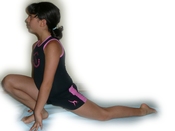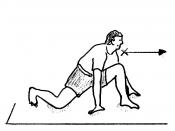Flexibility is a very important component of personal fitness. Flexibility is defined as a personÃÂs ability to move a muscle or joint through a full range of motion. The amount of flexibility a person has can be seen by their ability to bend, twist, or stretch.
Flexibility is directly related to personal health. It is directly related because increased flexibility helps to reduce the risk of injuries. This is because the limb is able to move further before an injury will happen. It also helps to reduce the amount of muscle tightness. It helps to preserve range of motion, to promote circulation, and to help develop body awareness. Zit helps to reduce cramping and also helps to control stability. In order to improve stretching, one should stretch at least 3 times a week. You should hold each stretch for 10 seconds and then work up to 30 seconds. You should repeat each stretch about 3-5 times, and the intensity should be to a position of mild discomfort, but not pain.
Some everyday stretches are the spinal twist, the hamstring stretch, the chest stretch, the calf stretch, the shoulder stretch, the quadriceps stretch, the forearm stretch, the triceps stretch, the inner thigh stretch, and the back stretch. If you follow this stretch program it will help you to become more flexible, and will help to bring on the health benefits that come with stretching.
There are many interesting facts about flexibility. First, women tend to be significantly more flexible than men at all ages. Second, as your age increases your flexibility usually tens to decrease. Many times this is often attributed to inactivity, but it can be attributed to the aging process. Third, timing is important in stretching. You should warm up before stretching to allow an increase in blood flow, which will help to muscles to be elastic-like. Some other facts about flexibility are that a person who is more active tends to have better flexibility than someone who is sedentary. There are three different types of flexibility. The first is dynamic flexibility which is the ability to perform dynamic movements within the full range of motion in the joint. An example of this would be being able to twist from side to side. The second type is static active flexibility which is the ability to stretch an antagonist muscle using on the tension in the antagonist muscle. An example of this would be holding one leg out in front of you trying to hold it as high as possible. The final type of flexibility is static flexibility, which is the ability to hold a stretch using body weight or an external force. An example of this would be holding your leg in front of you and letting it rest on a chair.
Works Cited"Flexibility Training Section." Sports Fitness Advisor. 2008. 1 Oct. 2008 .
Kinesiology and Health. Dept. home page. 5 Jan. 1998. Georgia State University. 1 Oct. 2008.
"9 Facts About Flexibility and Stretching." Little Rock Marathon. 1 Oct. 2008.





